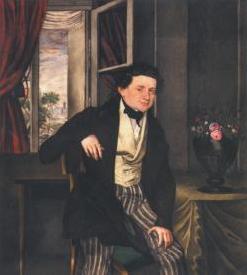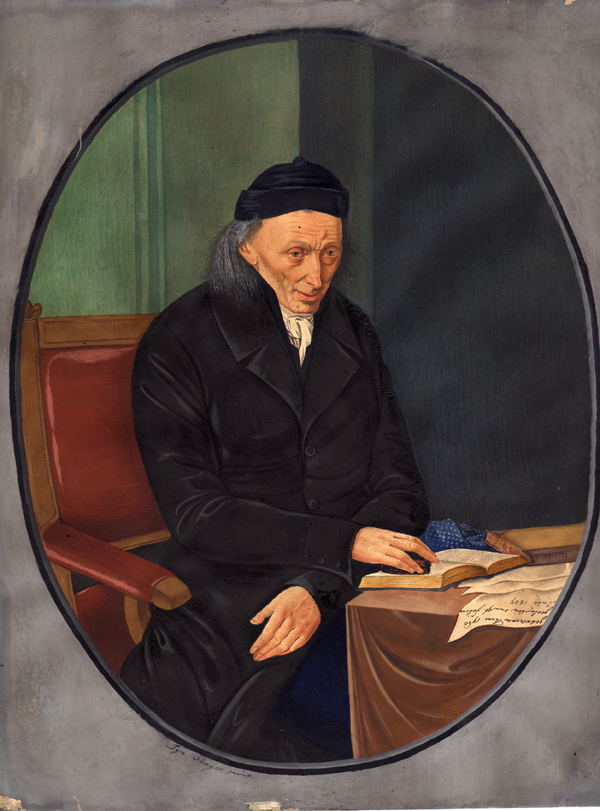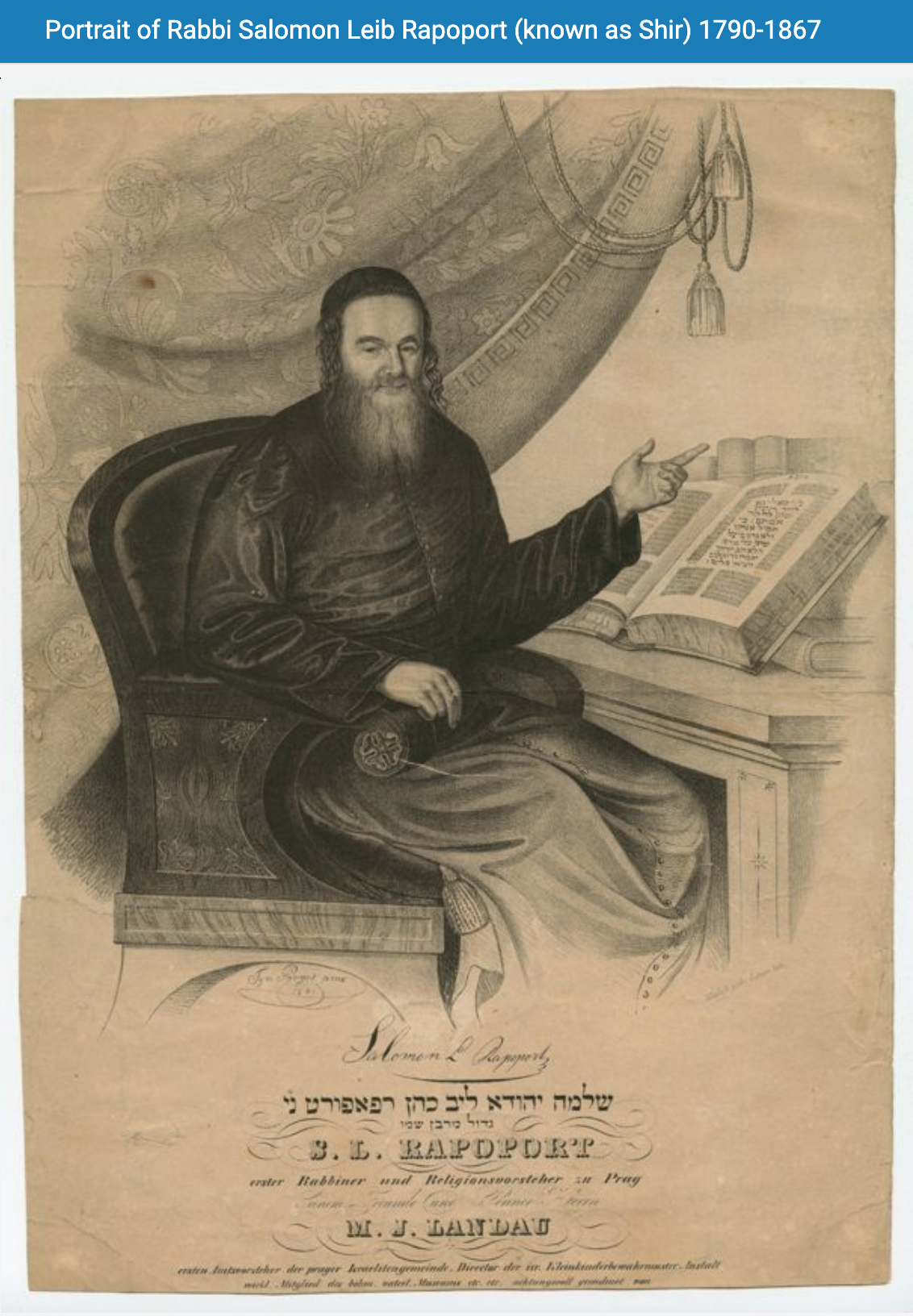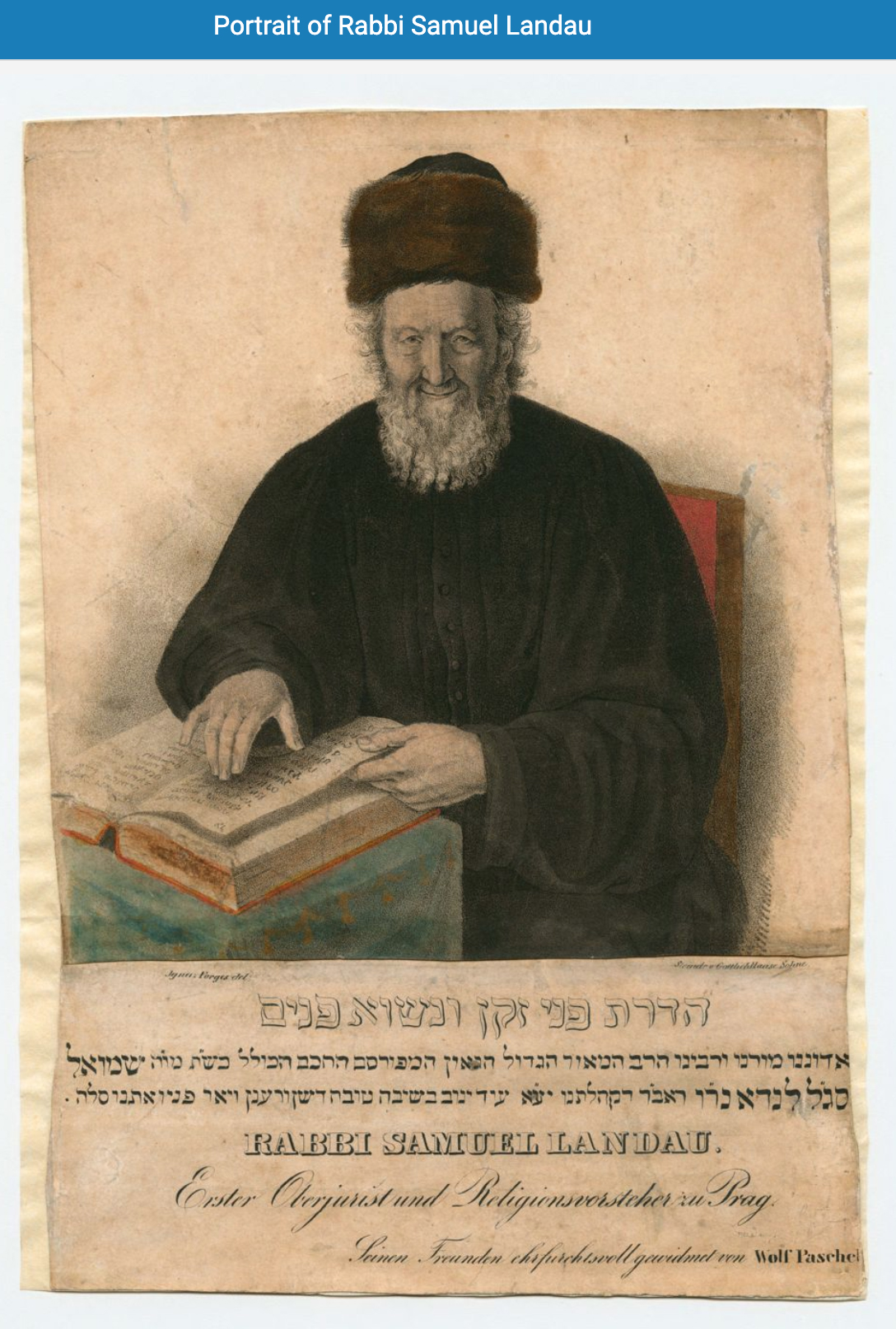|
"During the second decade
of (Josef) Bergler's directorship (of the Academy of Fine Arts established
in Prague in 1800) a generation studied at the academy whose work
preempts Prague's romanticism by being a bizarre synthesis of the
one-time classicism and historical romanticism.
Josef Fuhrich became
representative of the trend ... and in 1829, Ignàc Josef
Porges, who proceeded to
become a specialist in the honest portrait ...
The Jewish students at the academy indulged in Jewish themes on
a modest scale only ...
Ignàc Josef Porges provided the portrait of Rabbi Salomon
Judah Rapoport in 1843 ....
Least romantic of all was Ignàc Josef Porges. His eagle
eye approximated the lens of a camera, and in effect he did at
times make his living at daguerreotyping and photography.
An ardent lover of truth, it was with great reluctance that he embellished
his female models even a little.
(He liked to use colorful wraps - Indian scarves.) Portraits of
young men were set in landscapes, painted skillful ; those of
older men he preferred in the actual sanctum of their study, and
there he was most at home.
Toman said of Porges that he selected "motley Jewish types clad
in outlandish garments" and Jirik wrote of him, in 1930, that
Porges demonstrated "an oriental
penchant for colorful imagery".
Nothing of the sort approaches the truth. Porges is virtual fanatic
of the sober, down-to-earth, microscopic realism, quite common in
Prague in those times."
Source : The Jews in Czechoslovakia
(1971), Vol II, (p.471-472) ; chapter : Jewish artists in the historic
lands
(The Jewish Publication Society of America, Philadelphia / Society
for the History of Czechoslovak Jews, New York)

Ignác J. Porges : Vilém
Karel Karpeles, 1836
|
Images of the Prague Ghetto
The exhibition Images of the Prague Ghetto has been on view at
the City of Prague Museum since the middle of May (2006). Featuring
200 unique images from the 18th century through the 20th, this
gives a vivid picture of the main monuments of Prague’s
Jewish Town. The show comprises three main sections.
The first
part contains portraits of rabbis and families in the ghetto
The second focuses on the most important sites of the ghetto,
particularly the Old-New Synagogue and the Old Jewish Cemetery.
Most of the depictions of the Jewish Town by Prague painters
date from the period of its reconstruction (which also led to
the founding of the Jewish Museum in Prague).
The need to represent a society undergoing a process of emancipation
led to the creation of a complete portrait gallery of the spiritual
representatives of the Prague Jewish community and of members of
patrician and entrepreneurial families in the Jewish Town.
The
best Prague portraitists, such as Antonín Bayer and Antonín
Machek, were receiving commissions from clients in the ghetto by
the beginning of the 19th century; the first Jewish graduates of
the Prague Academy soon followed suit.
Ignác
Josef Porges was
one of the most acclaimed Jewish portraitists in 19th century Prague.
The Old-New Synagogue attracted the attention of artists at the
beginning of the 19th century.
Their engravings from the 1830s
were used as illustrations for the first guidebooks for Prague.
The most important work is a watercolour by Josef Mánes
that depicts the Old-New Synagogue interior.
The Old Jewish Cemetery
was also a popular subject for several generations of artists.
Exhibition catalogue It was first painted by Antonín Mánes,
but the most important painters of the cemetery were Bedrich Havránek
and Matyáš Wehli who depicted picturesque clusters
of tombstones near Pinkas Synagogue with views of Prague Castle.
Cemetery views also became a popular motif for Art Nouveau graphic
artists.
The decision to reconstruct the Jewish Town and the start
of its demolition around 1896 produced a wave of broader interest
in the Prague ghetto.
Artists sought to document the form of the
ghetto’s vanishing streets and corners.
Among the most important
ghetto painters from this period was Václav Jansa; others
included Ludek Marold, Václav Hradecký, Jindrich
Jakesch and Josef Douba.
Antonín Slaví?ek painted
his most famous views of the Jewish and Old Towns at the turn of
century.
Traditional motifs of the Prague ghetto were also depicted
in many replicas by the naive painter Adolf Kohn in the 1920s and
30s.
Due to the numerous works by several generations of Prague painters
and graphic artists, the demolished Jewish Town is now, paradoxically,
among the best documented historic parts of Prague.
This exhibition is co-held by the Prague 1 Borough.
Source : Jewish Museum
Prague 2006

Painting by Ignác Porges |

|
 |
Portrait of Chief
Rabbi of Prague
Solomon Judah Löb Rapoport
born Lemberg June 4,1790 died Prague October 16,1867
Prague, 1841 |
Portrait of
Rabbi Samuel Landau |
Lithograph on paper,
538 x 436 mm, signed and dated lower left in the lithographic
stone: Ign. Porges / 1841
Provenance: acquired by the Central Jewish Museum in 1942-1944;
incorporated into the museum’s collections by Dr. Josef
Polák; selected from the Treuhandstelle warehouse where
the item was sent after being seized from the property of Alb?ta
Hájková from Prague (b. 23 May 1879. Hájková was
deported from Prague to Terezín on Transport AAn on
6 July 1942, from where on 14 July 1942 she was sent on Transport
AAx to Maly Trostinec, where all trace of her was lost)
The third day of Sukkot on the 17th of Tishri in the Hebrew
calendar (which this year falls on 29 September in the Gregorian
calendar) marks the 140th anniversary of the death of the prominent
scholar and rabbi Solomon Judah Löb Rapoport. Also known
by the acronym “Shir”, his career is closely linked
to the Prague Jewish community. Rapoport was born in 1790 in
the Galician town of Lvov (then Lemberg, part of the Austro-Hungarian
Monarchy). Despite receiving a traditional Orthodox education,
he soon moved towards the Jewish Enlightenment (Haskalah) and
became a devoted promoter of the Science of Judaism (Wissenschaft
des Judentums). Based on a critical study of the Tanakh, Talmud
and rabbinic literature, he put together an encyclopaedic dictionary
of Judaism entitled Erekh Millin (published by M. I. Landau,
Prague, 1852, Vol I.). In 1840 he accepted the position of
Chief Jurist of the Prague Jewish community, where he remained
until his death in 1867. He is buried in the Jewish cemetery
in Fibichova Street in the ikov district of Prague.
The collections of the Jewish Museum in Prague contain several
portraits of Rapoport. The most famous of these is probably
a painting by the Prague portraitist Antonín Machek
(JMP 12.574) and a related lithograph by Machek’s colleague
František Šír (JMP 60.723). In Ignác
Porges’s lithograph, Rapoport is depicted as an enlightened
scholar interpreting a passage from the Book of Job (VIII,
8-10): “For inquire of the former generation, and apply
thyself to that which their fathers have searched out. For
we are but of yesterday, and know nothing, because our days
upon earth are a shadow. Shall not they teach thee, and tell
thee, and utter words out of their heart?.”
| ___________________________ |
Solomon Judah Löb Rapoport (June 1, 1790 in Lemberg, Kingdom
of Galicia and Lodomeria, Austria – October 16, 1867 in Prague)
, was a Galician rabbi and Jewish
scholar.
After various experiences in business,
Rapoport became successively rabbi of Tarnopol (1837) and of
Prague (1840). He was one of the founders of the new "Wissenschaft des Judentums" movement.
His chief work was the first part of an (unfinished) encyclopaedia
(Ereklz Millin, 1852). Equally notable were his biographies of
Saadia Gaon, Nathan (author of the Arukh), Hai Gaon, Eleazar Kalir
and others.
Thrown upon his own resources about
1817, Rapoport became cashier of the meat-tax farmers. He had
already given evidence of marked critical ability, though his
writings previously published were of a light character—poems
and translations. His critical talent, however, soon revealed
itself. In 1824 he wrote an article for Bikkure ha-'Ittim on
the independent Jewish tribes of Arabia and Abyssinia. Though
this article gained him some recognition, a more permanent impression
was made by his work on Saadia Gaon and his times (published
in the same journal in 1829), the first of a series of biographical
works on the medieval Jewish sages. Because of this work he received
recognition in the scholarly world and gained many enthusiastic
friends, especially S. D. Luzzatto (Bernfeld, Toledot Shir, p.
33).
After the fashion in rabbinic circles,
Rapoport was known by an acronym "Shir", formed by
the initial letters of his Hebrew name Shelomo Yehuda Rapoport.
Source : http://en.wikipedia.org/wiki/Samuel_Judah_L%C3%B6b_Rapoport (2008)
|



